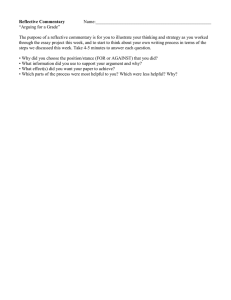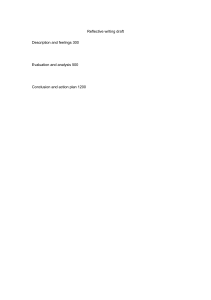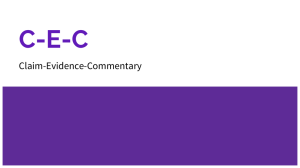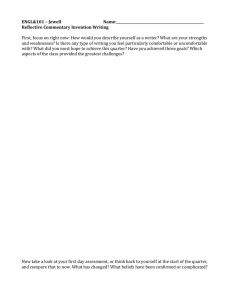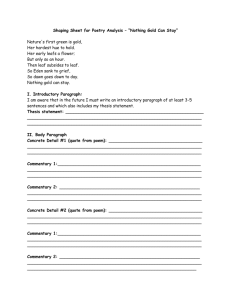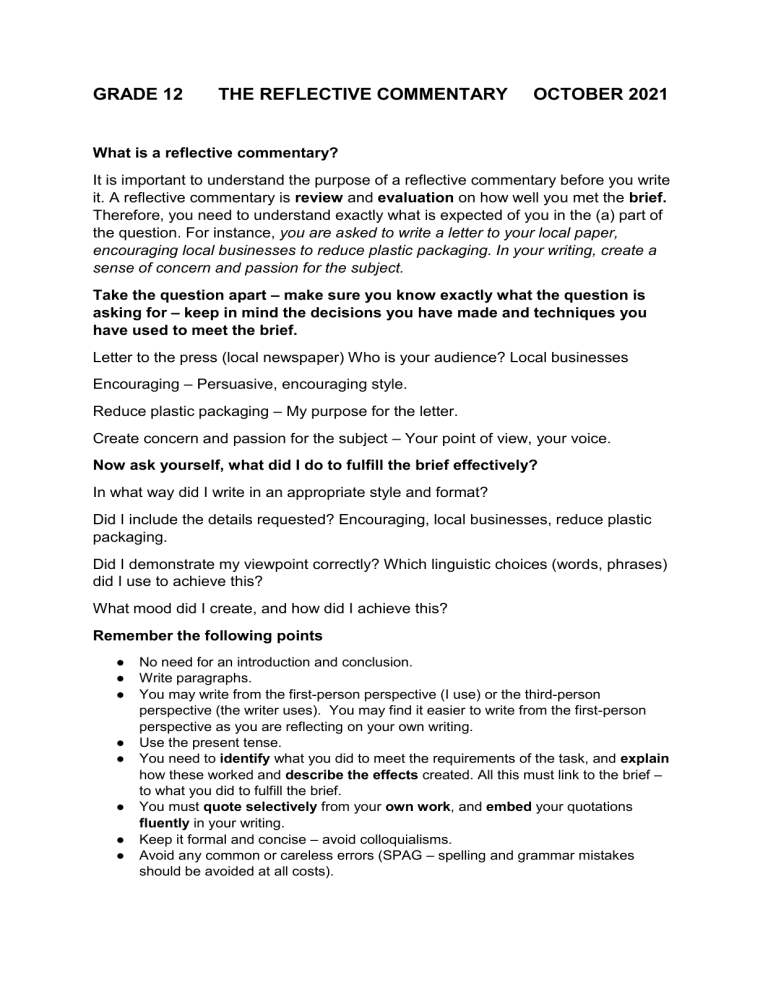
GRADE 12 THE REFLECTIVE COMMENTARY OCTOBER 2021 What is a reflective commentary? It is important to understand the purpose of a reflective commentary before you write it. A reflective commentary is review and evaluation on how well you met the brief. Therefore, you need to understand exactly what is expected of you in the (a) part of the question. For instance, you are asked to write a letter to your local paper, encouraging local businesses to reduce plastic packaging. In your writing, create a sense of concern and passion for the subject. Take the question apart – make sure you know exactly what the question is asking for – keep in mind the decisions you have made and techniques you have used to meet the brief. Letter to the press (local newspaper) Who is your audience? Local businesses Encouraging – Persuasive, encouraging style. Reduce plastic packaging – My purpose for the letter. Create concern and passion for the subject – Your point of view, your voice. Now ask yourself, what did I do to fulfill the brief effectively? In what way did I write in an appropriate style and format? Did I include the details requested? Encouraging, local businesses, reduce plastic packaging. Did I demonstrate my viewpoint correctly? Which linguistic choices (words, phrases) did I use to achieve this? What mood did I create, and how did I achieve this? Remember the following points ● ● ● ● ● ● ● ● No need for an introduction and conclusion. Write paragraphs. You may write from the first-person perspective (I use) or the third-person perspective (the writer uses). You may find it easier to write from the first-person perspective as you are reflecting on your own writing. Use the present tense. You need to identify what you did to meet the requirements of the task, and explain how these worked and describe the effects created. All this must link to the brief – to what you did to fulfill the brief. You must quote selectively from your own work, and embed your quotations fluently in your writing. Keep it formal and concise – avoid colloquialisms. Avoid any common or careless errors (SPAG – spelling and grammar mistakes should be avoided at all costs). ● Remember you only have 200 words: this word count excludes the quotes. Safe to allow yourself up to 250 words. Points I have focused on in my reflective commentary 1. Form The typical text conventions you used to fulfil the brief effectively. The ways in which the purpose of your text has been presented. The ways in which your text appeals to its intended audience, e.g. through the tone and register used in the text. 2. Structure The ways in which you used headings, short/long paragraphs (structural/chronological), shift in focus/tense, bullet points, discourse markers to achieve the purpose set by the brief. Did you use short, percussive/long, complex sentences? Did you juxtapose these two types for a specific effect? Did you use a variety of sentence types: interrogative, simple statements, declarative, imperative, and exclamatory? How did the sentence types you used help you fulfil the brief? Try to use more than one type and comment on it. Tense shifts – simple perfect to simple present/present continuous and the effect on the reader The use of internal dialogue and alternating paragraphs – shifts from the external to the internal. Use of repetition The use of ellipsis, dashes and how these affect the pace of the text 3. Language Which linguistic features did you decide to use? Did you use alliteration, sibilance, rhetorical devices, hyperbole or any other? Why did you use it? How did it help to create a specific mood or atmosphere? Did you use first/second/third speaker and why? What effect did you want to achieve? What parts of speech did you select to add effect? Adverbs/verbs/adjectives/adverbs/emotive words/verbs. How does this word/phrase add effect to your text? How does it help to fulfil the purpose? How did I create imagery? POSSIBLE STRUCTURE OF REFLECTIVE COMMENTARY (It does not have to follow the same pattern, but it might be effective to structure it this way.) NO INTRODUCTION PARAGRAPH 1 Start with a positive point (I have successfully achieved…) about the way you addressed form in your text. Focus on how you used the specific conventions of the text to speak to your audience and to make your purpose clear as was instructed by the brief. Use quotes from your writing piece to prove your point, and mention why this is effective. PARAGRAPH 2 Now make a positive point (The way I used discourse markers contributed positively…) about the way you applied structure to meet criteria set by the brief. Add how you used the specific structure and why it is effective. Use quotes from your writing piece to prove your point. For example: ‘In terms of structure I used discourse markers (such as ‘Firstly …’) and chronological order to organise the text into sections which would make it easy for readers to understand and grasp the order of events. These features are conventional in news stories as they help provide an organised, time-based account of a specific event or occurrence.’ PARAGRAPH 3 Follow it with another positive point on the language choices you made for your text. Add how they fulfil the criteria set by the brief, and why it helped to create specific feelings/mood/tone. Again, use specific quotes from your writing piece to prove your point and remember to explain why these words are effective. PARAGRAPH 4 Lastly, reflect on what you could have done better. You can say something like On reflection. I feel that I achieved my purpose in my writing. At first I thought I could have used more emotive language to strengthen the sympathy I wanted to create, as that was my main purpose. However, I feel I struck a good balance to create empathy without coming across too melodramatic.
